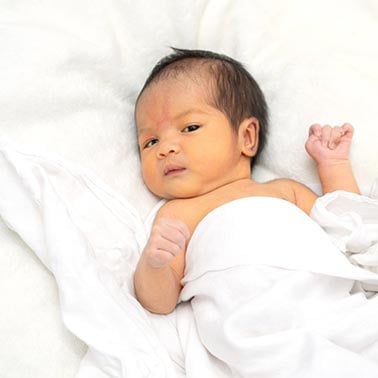What is jaundice in babies?
Some babies are born with a condition called jaundice. It doesn’t affect all babies and although most cases will get better without treatment, some babies will need special care.
Jaundice is a condition in babies when they are first born that can cause your baby’s skin and the whites of the eyes to look yellow. It is usually harmless but, in some cases, needs medical attention. The medical name for this condition is neonatal jaundice.
What causes jaundice in babies?
Jaundice occurs when your baby has too much of a substance called bilirubin in their blood. This is called ‘hyperbilirubinaemia’. Bilirubin is produced when red blood cells break down, creating a yellow substance that is usually excreted from the body via the liver into your baby’s poo. However, if there is too much bilirubin, the liver can’t cope, and this is what causes jaundice. Experts advise that you keep a close eye on the colour of your baby’s poo when you wipe.
It is a problem in babies because they are born with a high number of red blood cells that are constantly being broken down and replaced—but also because their liver is not yet fully developed, so can’t cope with eliminating the bilirubin.
How is jaundice diagnosed in babies?
Your medical team will carry out a series of health checks on your baby when they are born. One of these tests will look for the tell-tale yellow tinge to the eyes and skin that means your little one has jaundice.
However, even if this is not picked up after the birth, you should still keep an eye on your baby after you have come home from hospital, as jaundice can take up to a week to appear. Check their wee too, as normal baby wee is clear, while if they have jaundice, it is yellow. If you think your baby may have jaundice, speak to your health visitor or GP at once.
For more severe cases, your medical team will use one of the following two methods to determine jaundice:
-
They may take a small blood sample from your baby’s heel; the blood serum is then measured to check the level of bilirubin
-
They may use a monitor called a bilirubinometer, which shines light onto the skin and can calculate the levels of bilirubin
If jaundice does not leave your baby after two weeks, they may need further tests to examine different elements of your baby’s blood.
How to treat a baby with jaundice
With mild jaundice, you will usually be sent home with your baby and asked to keep an eye on it. Your health visitor will also check your baby’s progress.
Sometimes, your baby may have a more serious form of jaundice and there is a risk that this might cause a rare complication called kernicterus. This can cause brain damage, so it’s something that needs to be treated.
Symptoms include being irritable, feeding poorly, having fits and seizures, a high-pitched cry, muscle spasms, being floppy and lethargic and having pauses in their breathing.
How long does baby jaundice last?
The good news is that if your baby has mild jaundice, it will usually resolve itself within a couple of weeks, as the levels of bilirubin lower and the baby’s liver becomes more efficient.
For more information on baby jaundice visit the NHS website for further advice about newborn jaundice, or read the guidance offered by the National Institute for Health and Care Excellence (NICE).


 your parenting partner
your parenting partner